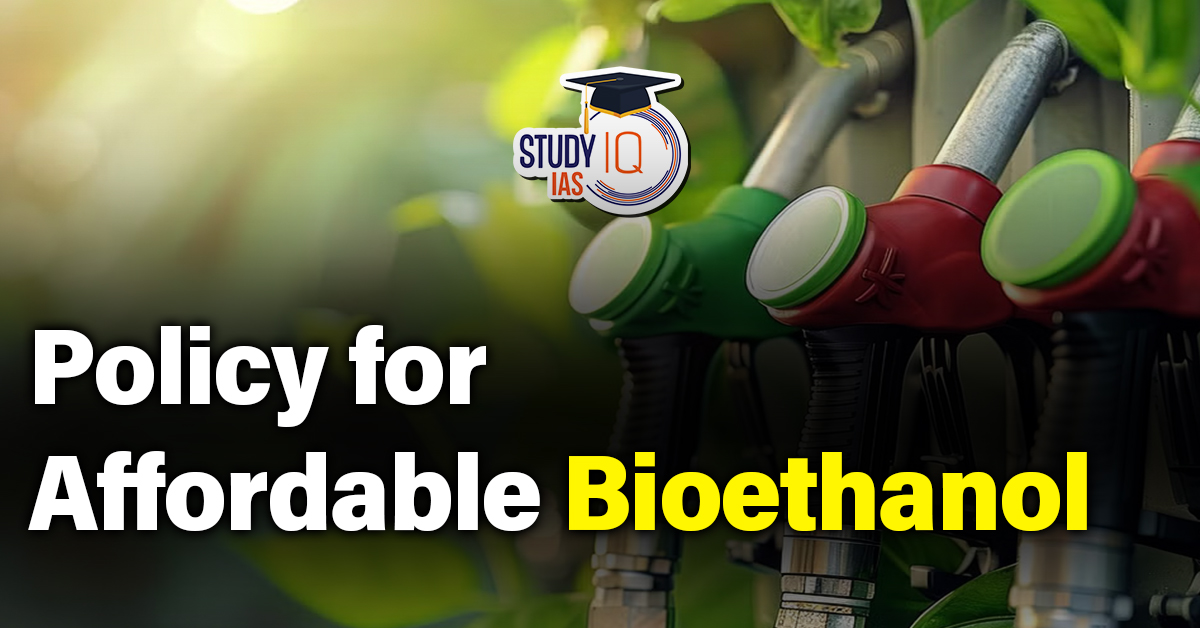Table of Contents
Context
- According to chief engineer Hiroya Ueda of Honda Motor Co Ltd., India has the advantage of achieving carbon neutrality through bioethanol and renewable energy-based electrification.
- However the government needs to create a mechanism to make prices of bioethanol fuel more affordable to make it economically viable for users
What is Bio Ethanol?
Bioethanol is a type of ethanol (ethyl alcohol, C2H5OH) derived from biological sources, primarily used as an alternative fuel to petrol in road transport vehicles.
| About Ethanol |
|
Production of Bioethanol
Bioethanol is mainly produced through two methods:
- Fermentation Process: The most common method involves fermenting sugars from crops such as corn, maize, wheat, sugar beet, and energy crops like sorghum and Jerusalem artichoke. The sugars from these crops are converted into ethanol by yeast fermentation.
- Chemical Process: Ethanol can also be produced by reacting ethylene with steam in a chemical reaction.
Advantages of Bioethanol
- Renewable Resource: Bioethanol is produced from crops, a renewable resource, unlike finite fossil fuels.
- Reduction in Greenhouse Gas Emissions: Grain-based ethanol cuts greenhouse gas emissions significantly by 44 to 52% compared to gasoline, according to the US Department of Energy’s Argonne National Laboratory.
- Extension of Oil Supplies: Blending bioethanol with petrol helps conserve limited oil supplies, reducing dependence on oil-producing nations, and contributing to fuel security.
- Rural Economy Benefits: Increased demand for bioethanol leads to the growth of energy crops, thereby benefiting the rural economy.
- Environmental Safety: Bioethanol is biodegradable and far less toxic than fossil fuels, causing minimal environmental pollution if spilled.
- Improved Air Quality: Bioethanol can reduce carbon monoxide emissions, especially in older vehicle engines, improving air quality.
- Integration with Existing Infrastructure: Bioethanol can be blended with petrol up to 10% (E10) without requiring modifications to vehicle engines or warranties. It can also be used in flexible fuel vehicles (E85, up to 85% ethanol).
- Oxygenation of Fuel: Blending ethanol with petrol allows for more complete combustion, reducing pollutants and improving fuel efficiency.
What are the Challenges Associated with Ethanol Blending?
- Production Challenges: The government’s target to achieve 20% ethanol-blended petrol by 2024-25 is facing setbacks due to restrictions on ethanol production from sugarcane juice in 2023-24.
- Vehicle Compatibility: Vehicles in India are currently designed for E0 and calibrated for E10 (10% ethanol blend).
- Using E20 (20% ethanol blend) may result in a loss of fuel efficiency – approximately 6-7% for four-wheelers and 3-4% for two-wheelers.
- Modifications in engines are required to reduce this efficiency loss.
- Moreover, the use of E20 will necessitate changes to the fuel lines, as well as some plastic and rubber parts, due to the corrosive nature of the fuel.
- The engines will also need to be recalibrated for the required power, efficiency, and emission-level balance due to the lower energy density of the fuel.
- Impact on Emissions: There are concerns regarding unregulated emissions such as acetaldehyde, which could be higher with E10 and E20 compared to normal petrol.
- The overall impact on emissions, both regulated and unregulated, needs careful monitoring and assessment as India progresses towards higher ethanol blending.
- Potential for food scarcity: Diverting crops for fuel can reduce food availability, leading to higher prices and food insecurity.
- Competition for land: Biofuel crops can compete with food production and conservation needs, potentially leading to land-use changes and biodiversity loss.
- Minimum Support Price: Ethanol production costs in India are higher compared to countries like the U.S. and Brazil. This is partly due to the government-fixed cost of raw materials like sugarcane and food grains, which are set to support farmers. This policy impacts the economic viability of the Ethanol Blending Programme (EBP).

| Government Efforts To Advance Ethanol Blending In India |
|
Way Forward
- E20 Mission for Fuel Independence: India’s aim to lessen its dependency on fuel imports through the E20 initiative is commendable, but the 2025-26 target is ambitious.
- Competition for Resources: Achieving this goal may lead to a clash for crop and land resources between fuel and food crops, necessitating a balanced approach.
- Addressing Undernourishment: With a significant undernourished population, India needs to expand the cultivation of pulses, oilseeds, and horticultural crops.
- Focus on Agricultural Productivity: Enhancing crop yields through advanced seeds and farming techniques is crucial, especially if these crops are used for biofuel production.
- Land-Use Planning: A strategic plan for land use is vital to avoid dedicating existing croplands to fuel production, considering the decline in arable land in India.
- Utilising Fallow Land: Prioritising the use of the increased fallow land, around 4.3 million hectares between 1978-79 and 2018-19, for biofuel crop production could be a solution.
- Second Generation (2G) Biofuel Technologies: These technologies, which use waste materials like wheat straw, corn cobs, wood, and agricultural residues for bioethanol production, should be further researched and developed for commercial viability.
- Avoiding Food vs. Fuel Dilemma: The roadmap should ensure no trade-off between achieving food and energy security, as both are equally important.


 Development Challenges in the Himalayas ...
Development Challenges in the Himalayas ...
 Building Climate Resilient Cities for Fu...
Building Climate Resilient Cities for Fu...
 Bioluminescence: Meaning, Causes, Exampl...
Bioluminescence: Meaning, Causes, Exampl...






















